
CONTINUING GROWTH The mining industry needs to be nurtured so that it continues to generate revenues to diversify the economy
Photo by: Duane Daws
Having reviewed the 2015 national Budget in October, the Zambia Chamber of Mines (CoM) believes the new mining tax regime is unsustainable and that it will have a negative effect on the growth of Zambia’s mining industry.
“Our sincere appeal to government is that the mining industry needs to be nurtured so that it continues to generate revenues to diversify the economy and continues to progress on the path of increasing mining and manufacturing production to sustain and continue to create jobs,” says Zambia CoM president Jackson Sikamo.
The Zambia mining industry will continue to be the engine of its economy for years to come, which is why the CoM strongly advises government to reverse its proposed new tax regime, says Sikamo.
Changes to the Mining Fiscal Regime
Zambia Mines Minister Christopher Yaluma has suggested a redesign of the mining fiscal regime by replacing the current two-tier system with a simplified mining tax structure.
It includes 8% minerals royalty tax (MRT) for underground mining operations as a final tax; 20% MRT for opencast mining operations as a final tax; a 30% corporate income tax rate on income earned from tolling and from the processing of purchased mineral ores, concentrates and any other semi-processed minerals currently taxed as income from mining operations.
Minerals Royalty Tax
Sikamo says that MRT is based on gross revenue and does not take operating costs into account. He explains that it is a cash tax, which companies have to pay monthly, even when they do not generate enough cash flow or when it may not be possible.
He further notes that MRT does not encourage capital investment. Company income tax or corporation tax enables capital allowances during the period of investments, he says.
“This concept takes away the principle of company income taxation, which is critical, especially in mining with long-term projects, such as shaft sinking and smelter building or upgrading,” highlights Sikamo.
He adds that, depending on a company’s profitability level, the current 6% MRT is already high, as it effectively gives a company up to 30% additional tax on the profit and/or earnings before the tax line.
“Our goal is to advance the interests of our members, local communities, the country and all stakeholders, while promoting sustainable and responsible mining,” concludes Sikamo.